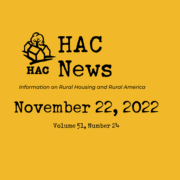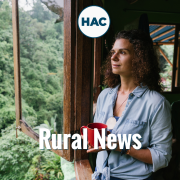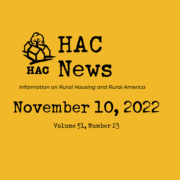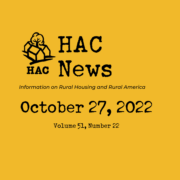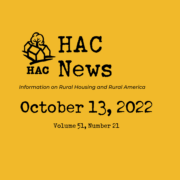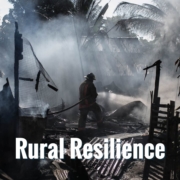HAC News: November 22, 2022
TOP STORIES
Congressional lame duck session must address spending, possibly tax measures
Remaining business for the outgoing Congress includes providing funds to keep the federal government open beyond the December 16 expiration of the current continuing resolution. Legislators may also decide to extend expiring tax measures before the end of December, and could use that bill to expand the Low Income Housing Tax Credit.
HAC testifies on persistent poverty before House subcommittee
Lance George, HAC’s Director of Research and Information, was one of several witnesses at a November 15 hearing on Persistent Poverty in America: Addressing Chronic Disinvestment in Colonias, the Southern Black Belt, and the U.S. Territories before the House Subcommittee on Housing, Community Development and Insurance. His testimony described persistent poverty’s impacts in these largely rural places.
Senators mention housing needs during Farm Bill hearing
Farm Bill 2023: Rural Development and Energy Programs, a Senate Agriculture Committee hearing on November 15, featured testimony from USDA Under Secretary for Rural Development Xochitl Torres Small and others. Although rural housing is generally under the jurisdiction of the Senate Banking Committee rather than the Ag Committee, Senators Tina Smith (D-Minn.), who serves on both panels, and Sherrod Brown (D-Ohio), who chairs the Banking Committee, mentioned rural housing needs during the hearing.
RuralSTAT
In 2021, people 65 years and older made up more than 20% of the population outside metro areas for the first time in U.S. census history, up from 16% in 2010. Source: USDA Economic Research Service, Rural America at a Glance: 2022 Edition.
OPPORTUNITIES
Healthy Homes and Weatherization Cooperation Demonstration funds available
Nonprofits and state, local, or tribal governments that have active DOE Weatherization Assistance Program grants or HUD Healthy Homes Production grants are eligible for Healthy Homes and Weatherization Cooperation Demonstration grants. Awards may be used for housing interventions in lower-income households that are served by both programs to determine whether coordination between the programs is cost-effective and leads to better outcomes in improving the safety and quality of homes. The deadline is January 5. For more information, contact Brenda M. Reyes, HUD.
Project for Public Spaces Community Placemaking Grant applications due
The Project for Public Spaces Fall 2022 Community Placemaking Grant closes November 28. Two selected applicants will receive $75,000 grant awards for physical and programmatic improvements to outdoor public spaces and technical assistance for community placemaking. Nonprofits or local governments with projects in specific counties in 14 states are eligible.
REGULATIONS AND FEDERAL AGENCIES
Community investment programs comment deadline extended
Housing, community facilities, and broadband programs are included along with programs to strengthen community lenders, small businesses, and more, in a request for comment from the new Interagency Community Investment Committee, which hopes to improve the operations and delivery of federal community investment programs through stronger federal collaboration. The comment deadline is now December 19, rather than December 5 as originally announced. For more information, contact Viraj Parikh, Treasury Department, 202-923-5161.
USDA releases new but incomplete guidance on Violence Against Women Act
A new Guide for Administering and Complying with the Violence Against Women Reauthorization Act of 2013 (Attachment 6-K), issued September 30, provides explanations, examples, and forms to help USDA staff and multifamily property owners and managers comply with VAWA. It does not, however, include information about the VAWA Reauthorization Act of 2022, which took effect on October 1. Explanations of the expansions adopted in 2022 are available from the National Housing Law Project, which will also offer a webinar on November 29, The Violence Against Women Act 2022 Reauthorization: Overview and Updates.
FHA to accept private flood insurance
Effective on December 21, homeowners with mortgages insured by the Federal Housing Administration will have the option to purchase private flood insurance rather than federally backed insurance. Like USDA, VA, and Fannie Mae and Freddie Mac, FHA requires property owners (including owners of manufactured homes) who live in flood hazard areas to carry flood insurance. For more information, contact Elisa Saunders, HUD, 202-708-2121, or an FHA lender.
EVENTS
HAC offers USDA 502 packaging training in South Carolina
The three-day USDA Section 502 Direct Certified Loan Application Packaging Training, designed for those experienced in using Section 502, will provide participants with a strong understanding of 502 direct underwriting and packaging standards, which will ensure that submitted loan dockets are complete and accessible for processing. The course will be held in Charleston, SC, on December 6-8. Registration is $750. For more information, contact HAC staff, registration@ruralhome.org, 202-516-6271.
PUBLICATIONS AND MEDIA
90% of U.S. counties experienced climate disasters in last 10 years
Maps and data for the 50 states show county-by-county climate impacts in an Atlas of Disaster compiled by Rebuild by Design, APTIM, and iParametrics. Recognizing that disasters are experienced unequally based on underlying vulnerabilities such as race/ethnicity and income, the maps depict which areas have been hit the hardest by recent climate events, where recovery funds are focused, where people with high social vulnerabilities live, and which areas have the least energy reliability. The report’s recommendations focus on addressing inequities.
News reports describe homelessness for rural youth and elderly
Young and Homeless in Rural America, a New York Times article and podcast, describes the plight of homeless youth in rural Ohio, where the lack of support systems leaves schools and churches to fill gaps. The impact of rising housing costs on elders is covered in More Older Americans Become Homeless as Inflation Rises and Housing Costs Spike, a National Public Radio piece focusing on Montana, where a survey found 44% of older adults struggled with housing and only 10% considered housing affordable.
HAC
HAC seeks Portfolio Manager, Self-Help Housing; Research Associate; and Housing Specialist – Native American Communities
- The Portfolio Manager, Self-Help Housing is responsible for the overall asset management, monitoring and reporting for an assigned portfolio of primarily self-help housing loans made to entities engaged in affordable housing activities in rural communities throughout the United States. This position is eligible for telecommuting.
- The Research Associate conducts original research, manages data, and disseminates information that informs local strategies and national policies to improve conditions for rural Americans. This position is eligible for telecommuting.
- The Housing Specialist – Native American Communities is responsible for providing direct technical assistance, coaching, and training to tribal communities, tribal housing departments, tribal housing authorities, and nonprofit organizations serving tribal communities. Travel is required. This position is eligible for telecommuting.
National Rural Housing Conference set for October 2023
Mark your calendars and save the date! HAC’s National Rural Housing Conference will be held October 24-27, 2023 in Washington, DC and online.
Need capital for your affordable housing project?
HAC’s loan fund provides low interest rate loans to support single- and multifamily affordable housing projects for low-income rural residents throughout the U.S. and territories. Capital is available for all types of affordable and mixed-income housing projects, including preservation, new development, farmworker, senior and veteran housing. HAC loan funds can be used for pre-development, site acquisition, site development, construction/rehabilitation and permanent financing. Contact HAC’s loan fund staff at hacloanfund@ruralhome.org, 202-842-8600.
Please note: HAC is not able to offer loans to individuals or families. Borrowers must be nonprofit or for-profit organizations or government entities (including tribes).
Want to reprint a HAC News item?
Please credit the HAC News and provide a link to HAC’s website. Thank you!

